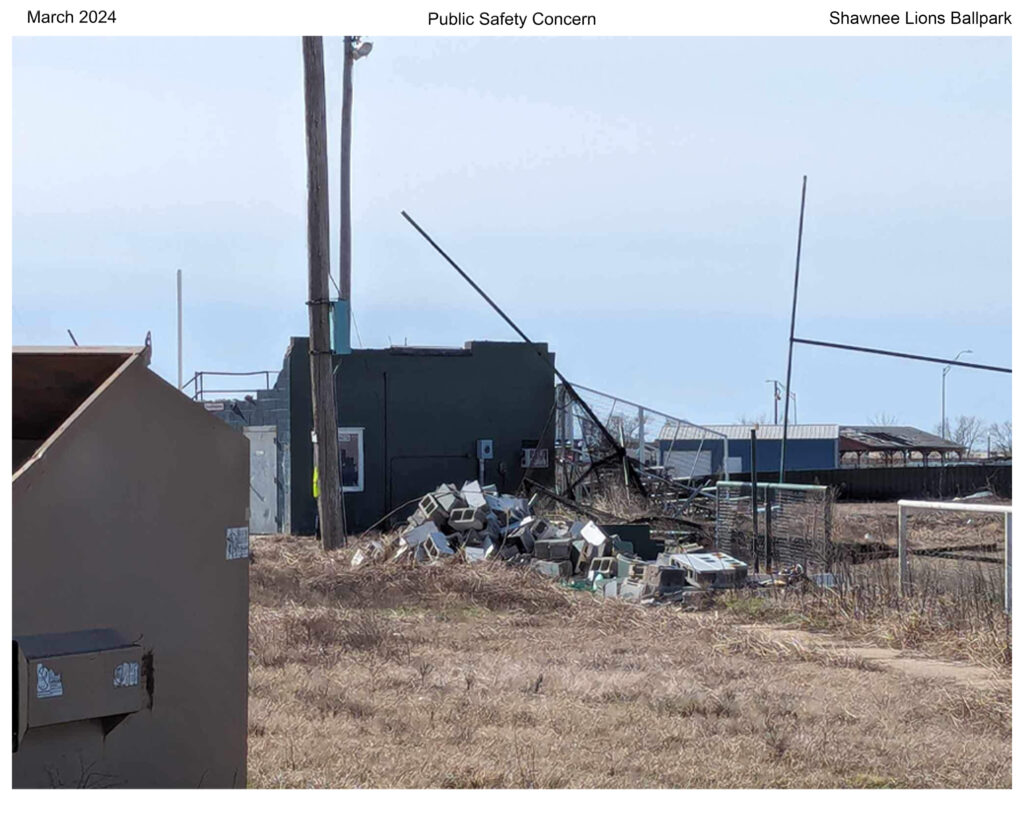Doctoral Lecture: Public Safety, Governance, and Liability – A Case Study of Lions Club Ballfields, Shawnee, OK
Introduction
- Overview: This lecture explores the public safety failures, legal responsibilities, and governance issues surrounding the Lions Club Ballfields in Shawnee, Oklahoma. Damaged by the April 2023 tornado, the ballfields remained in a hazardous state for 15 months, creating significant risks to the surrounding community, which includes the Shawnee YMCA and an early childhood center. Despite ongoing FEMA coordination and insurance claims, the city’s failure to take immediate action to mitigate these risks has raised concerns regarding municipal liability, public safety, and governance failures.
- Supporting Documentation: The original legal document, Instrument of Transfer No. 10739-47, will serve as supporting documentation, outlining the City of Shawnee’s obligations to maintain the property. Additional supporting documents include photos of the public safety risks at the Lions Club Ballfields, which will be included in the final printed report.
Key Timeline and Events
- April 19, 2023: A tornado strikes Shawnee, damaging the Lions Club Ballfields and other city assets.
- April 9, 2024: Shawnee issues a public notice for the demolition of the ballfields, with bids closing on May 6, 2024.
- February-March 2024: Photos taken during this time reveal significant public safety concerns, including scattered debris, damaged structures, and unsecured areas.
July 2024: The City of Shawnee begins the slow demolition process, removing debris and preparing the site for reconstruction.
- Public Safety Concerns
- Debris and Structural Instability:
- The ballfields remained largely unsecured for more than a year after the tornado, with visible piles of debris and structural remnants posing serious hazards.
- Damaged fencing and utility structures create safety concerns, particularly given the proximity to the YMCA and early childhood center.
- Environmental Risks:
- Soil contamination due to debris required the removal of the top 6 inches of soil during demolition. This environmental hazard added urgency to securing the area to protect public health.
- Proximity to Public Spaces:
- The Lions Club Ballfields share parking lots with the YMCA and early childhood center, making them highly accessible to the public. The proximity of these institutions heightened the danger of leaving the site open and exposed for an extended period.
- Debris and Structural Instability:
Legal and Governance Analysis
-
- City’s Duty of Care:
- Municipalities have a duty of care to maintain public property in a safe and secure condition. Shawnee’s failure to secure the Lions Club Ballfields despite clear safety hazards suggests potential negligence on the part of the city. The 15-month delay in addressing these concerns may constitute a breach of this duty, particularly since the city received public complaints during the Parks and Recreation Board meetings.
- Public Complaints:
- You attended two City of Shawnee Parks and Recreation Board meetings, raising concerns about the safety risks posed by the damaged ballfields. These complaints, voiced in public meetings, further strengthen the argument that the city was aware of the risks and failed to act in a timely manner.
- Liability of City Officials:
- City Manager: The city manager is responsible for daily operations and public safety. This role holds a greater degree of operational liability, and if the manager failed to address the safety hazards, they could be directly liable for negligence.
- Mayor: The mayor, as an elected official, may have limited personal liability, but could face civil action if gross negligence or failure to ensure safety protocols is demonstrated.
- FEMA and Insurance Delays:
- While FEMA and insurance coordination delayed the demolition, these external factors do not absolve the city of its responsibility to implement temporary safety measures.
- Reversionary Clause in Land Agreement:
- The Instrument of Transfer No. 10739-47 includes a reversionary clause that allows the federal government to reclaim the land if the city fails to maintain it. This clause may become relevant if Shawnee’s continued negligence results in further safety hazards or legal action.
- City’s Duty of Care:
Community Impact Analysis
- Geographical Scan:
- Population within a 1-mile and 2-mile radius of the ballfields is directly affected by the hazards posed by the park. The YMCA and early childhood center, both bordering the ballfields, have common parking lots with the park, increasing the exposure to risks.
- School Enrollment and YMCA Membership:
The early childhood center has significant enrollment, and the YMCA sees regular foot traffic from its membership base. These institutions serve vulnerable populations, further emphasizing the need for prompt safety measures.
Conclusions
- Negligence and Liability: Shawnee’s failure to address public safety hazards for over a year constitutes a negligent breach of duty. Temporary safety measures (e.g., fencing, signage) should have been implemented immediately to protect the public.
- Legal Liability: The City Manager may face personal civil liability for their role in delaying action, while the Mayor could also be named in lawsuits if gross negligence is proven. Civil suits are possible if accidents occur due to the city’s inaction.
- Improved Governance: Shawnee should implement clear protocols for securing public spaces after disasters. Immediate safety measures should be prioritized, even while awaiting FEMA or insurance approval.
Ongoing Monitoring: As the demolition proceeds, Shawnee should ensure that the site is secured and that no further public safety hazards arise. The city’s liability could increase if future delays or accidents occur during this process.
Photos
The following pages include the photographs of the Lions Club Ballfields documenting the public safety concerns from February-March 2024. These images are critical to understanding the severity of the risks posed by the delay in demolition and cleanup efforts.
Doctoral Lecture: Public Safety, Governance, and Liability
A Case Study of Lions Club Ballfields, Shawnee, OK
- This lecture explores the public safety failures, legal responsibilities, and governance issuessurrounding the Lions Club Ballfields in Shawnee, Oklahoma. Damaged by the April 2023 tornado,the ballfields remained in a hazardous state for 15 months, creating significant risks to thecommunity. The original legal document, Instrument of Transfer No. 10739-47, outlines the City ofShawnee’s obligations to maintain the property. Supporting documentation includes photographsshowing the public safety risks posed by the site’s neglect.
Key Timeline and Events
– April 19, 2023: A tornado causes severe damage to the Lions Club Ballfields
.– April 9, 2024: Shawnee issues a public notice for the ballfields’ demolition.
– February-March 2024: Photos reveal significant safety hazards, such as debris, structuralinstability, and environmental contamination.
– July 2024: City of Shawnee begins the demolition process.
Public Safety Failures and Risks
– Debris and Structural Instability: Unsecured debris, broken fencing, and unstable poles create
ongoing hazards. These conditions persisted for over a year.
– Environmental Contamination: Soil contamination due to debris required the removal of the top 6
inches of soil during demolition. This environmental hazard increased the urgency of securing the
area to protect public health.
– Proximity to Community Spaces: The ballfields are adjacent to the Shawnee YMCA and an early
childhood center, with shared parking lots, increasing exposure to safety risks.
Legal and Governance Analysis
– Document No. 10739-47: This Instrument of Transfer outlines Shawnee’s obligations, including
maintaining the property for public use and ensuring public safety. It also includes a reversionary
clause, allowing the federal government to reclaim the land if Shawnee fails to meet its
responsibilities.
– Negligence and Liability: The City Manager holds greater operational responsibility and liability for
public safety failures, while the Mayor may have limited personal liability.
– Public Complaints and Awareness: Public safety concerns were raised in Parks and Recreation
Board meetings, further demonstrating the city’s awareness of the hazards.

